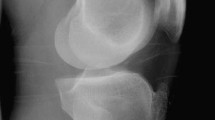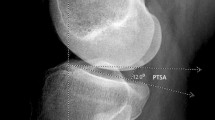Abstract
Introduction
A number of studies have examined the risk factors for Osgood–Schlatter disease (OSD). Studies on risk factors have not necessarily accurately demonstrated the risk factors of this disease because they were not prospective cohort studies or the populations in the studies were not categorized by the skeletal maturation of the tibial tuberosity. We can identify the precise risk factors for OSD by performing a prospective cohort study of a group of asymptomatic patients in particular times of adolescent using ultrasonography. In the present study, we aimed to investigate the precise risk factors for OSD.
Methods
For all examinations, we used a 3-stage classification for tibial tuberosity development observed on ultrasonography: sonolucent (stage S), individual (stage I), and connective stages (stage C). Among 150 players with 300 knees, we included 37 male players with 70 knees at asymptomatic stage I on the first examination. We re-examined the included knees 1 year after the first examination and compared 10 knees with OSD (OSD group) and 60 knees without OSD (control group). Height, body weight, body mass index, tightness of the quadriceps femoris and hamstring muscles, muscle strength during knee extension, and flexion were assessed during the first medical examination.
Results
The incidence of OSD was 14.3 % in this 1-year cohort study. A significant difference was found in body weight, quadriceps muscle tightness, and muscle tightness and strength during knee extension between the 2 groups. The precise risk factors for OSD were increased, namely the quadriceps femoris muscle tightness and strength during knee extension and flexibility of the hamstring muscles, using logistic regression analysis.
Conclusions
This information may be useful for teaching quadriceps stretching in preadolescent male football players with stage I.

Similar content being viewed by others
References
Czyrny Z (2010) Osgood–Schlatter disease in ultrasound diagnostic—a pictorial essay. Med Ultrason 12:323–335
De Flaviis L, Nessi R, Scaglione P, Balconi G, Albisetti W, Derchi LE (1989) Ultrasonic diagnosis of Osgood–Schlatter and Sinding-Larsen-Johansson diseases of the knee. Skeletal Radiol 18:193–197
de Lucena GL, dos Santos Gomes C, Guerra RO (2011) Prevalence and associated factors of Osgood–Schlatter syndrome in a population-based sample of Brazilian adolescents. Am J Sports Med 39:415–420
Ehrenborg G, Lagergren C (1961) Roentgenologic changes in the Osgood–Schlatter lesion. Acta Chir Scand 121:315–327
Ehrenborg G (1962) The Osgood–Schlatter lesion: a clinical study of 170 cases. Acta Chir Scand 124:89–105
Ehrenborg G (1962) The Osgood–Schlatter lesion. A clinical and experimental study. Acta Chir Scand Suppl 288:1–36
Gholve PA, Scher DM, Khakharia S, Widmann RF, Green DW (2007) Osgood Schlatter syndrome. Curr Opin Pediatr 19:44–50
Hirano A, Fukubayashi T, Ishii T, Ochiai N (2002) Magnetic resonance imaging of Osgood–Schlatter disease: the course of the disease. Skeletal Radiol 31:334–342
Kujala UM, Kvist M, Heinonen O (1985) Osgood–Schlatter’s disease in adolescent athletes. Retrospective study of incidence and duration. Am J Sports Med 13:236–241
Nakase J, Aiba T, Goshima K, Takahashi R, Toratani T, Kosaka M, Ohashi Y, Tsuchiya H (2014) Relationship between the skeletal maturation of the distal attachment of the patellar tendon and physical features in preadolescent male football players. Knee Surg Sports Traumatol Arthrosc 22:195–199
Ogden JA, Southwick WO (1976) Osgood–Schlatter’s disease and tibial tuberosity development. Clin Orthop Relat Res 116:180–189
Osgood RB (1903) Lesions of the tibial tubercle occurring during adolescence. Boston Med Surg J 148:114–117
Sarcevic Z (2008) Limited ankle dorsiflexion: a predisposing factor to Morbus Osgood Schlatter? Knee Surg Sports Traumatol Arthrosc 16:726–728
Schlatter C (1903) Verletzungen der schnabelformigen fortsatzes der obseren tibia epiphyse. Beitr Klin Chir 38:874–887
Stark T, Walker B, Phillips JK, Fejer R, Beck R (2011) Hand-held dynamometry correlation with the gold standard isokinetic dynamometry: a systematic review. PMR 3:472–479
Vreju F, Ciurea P, Rosu A (2010) Osgood–Schlatter disease—ultrasonographic diagnostic. Med Ultrason 12:336–339
Author information
Authors and Affiliations
Corresponding author
Ethics declarations
Conflict of interest
None.
Rights and permissions
About this article
Cite this article
Nakase, J., Goshima, K., Numata, H. et al. Precise risk factors for Osgood–Schlatter disease. Arch Orthop Trauma Surg 135, 1277–1281 (2015). https://doi.org/10.1007/s00402-015-2270-2
Received:
Published:
Issue Date:
DOI: https://doi.org/10.1007/s00402-015-2270-2




